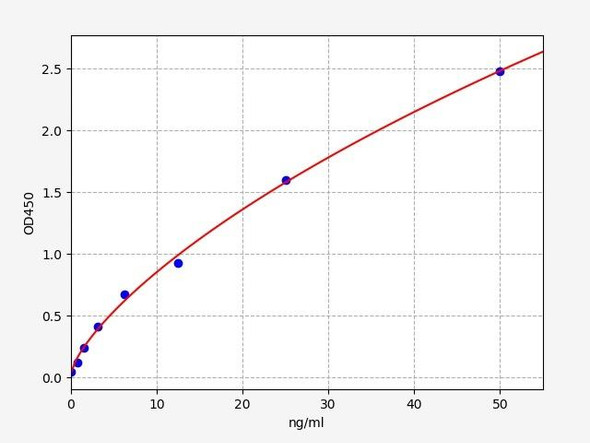Epigenetics & Nuclear Signaling Antibodies 5
Anti-LOXL2 Antibody (CAB4708)
- SKU:
- CAB4708
- Product Type:
- Antibody
- Antibody Type:
- Monoclonal Antibody
- Reactivity:
- Human
- Host Species:
- Rabbit
- Isotype:
- IgG
- Synonyms:
- LOR
- Synonyms:
- LOR2
- Synonyms:
- WS9-14
- Research Area:
- Epigenetics and Nuclear Signaling
Description
| Product Name: | LOXL2 Rabbit mAb |
| Product Code: | CAB4708 |
| Size: | 20uL, 50uL, 100uL |
| Synonyms: | LOR, LOR2, WS9-14 |
| Applications: | WB |
| Reactivity: | Human |
| Host Species: | Rabbit |
| Immunogen: | A synthesized peptide derived from human LOXL2 |
| Applications: | WB |
| Recommended Dilutions: | WB 1:500 - 1:2000 |
| Reactivity: | Human |
| Positive Samples: | A-549, PC-3 |
| Immunogen: | A synthesized peptide derived from human LOXL2 |
| Purification Method: | Affinity purification |
| Storage: | Store at -20°C. Avoid freeze / thaw cycles. Buffer: PBS with 0.02% sodium azide, 0.05% BSA, 50% glycerol, pH7.3. |
| Isotype: | IgG |
| Sequence: | Email for sequence |
| Gene ID: | 4017 |
| Uniprot: | Q9Y4K0 |
| Cellular Location: | Chromosome, Nucleus, Secreted, basement membrane, extracellular matrix, extracellular space |
| Calculated MW: | 53, 106kDa |
| Observed MW: | 100KDa |
| UniProt Protein Function: | LOXL2: Mediates the post-translational oxidative deamination of lysine residues on target proteins leading to the formation of deaminated lysine (allysine). When secreted in extracellular matrix, promotes cross-linking of extracellular matrix proteins by mediating oxidative deamination of peptidyl lysine residues in precursors to fibrous collagen and elastin. Acts as a regulator of sprouting angiogenesis, probably via collagen IV scaffolding. When nuclear, acts as a transcription corepressor and specifically mediates deamination of trimethylated 'Lys-4' of histone H3 (H3K4me3), a specific tag for epigenetic transcriptional activation. Involved in epithelial to mesenchymal transition (EMT) via interaction with SNAI1 and participates in repression of E- cadherin, probably by mediating deamination of histone H3. Also involved in E-cadherin repression following hypoxia, a hallmark of epithelial to mesenchymal transition believed to amplify tumor aggressiveness, suggesting that it may play a role in tumor progression. Acts as a regulator of chondrocyte differentiation, probably by regulating expression of factors that control chondrocyte differentiation. Belongs to the lysyl oxidase family. |
| UniProt Protein Details: | Protein type:Oxidoreductase; Secreted; Cell adhesion; Secreted, signal peptide; EC 1.4.3.13 Chromosomal Location of Human Ortholog: 8p21.3 Cellular Component: basement membrane; extracellular space; nucleoplasm; nucleus Molecular Function:chromatin binding; electron carrier activity; methylated histone residue binding; protein binding; protein-lysine 6-oxidase activity; transcription corepressor activity Biological Process: aging; cell adhesion; collagen fibril organization; endothelial cell migration; endothelial cell proliferation; epithelial to mesenchymal transition; histone modification; negative regulation of transcription, DNA-dependent; positive regulation of chondrocyte differentiation; protein amino acid deamination; protein modification process; response to copper ion; response to hypoxia; sprouting angiogenesis |
| NCBI Summary: | This gene encodes a member of the lysyl oxidase gene family. The prototypic member of the family is essential to the biogenesis of connective tissue, encoding an extracellular copper-dependent amine oxidase that catalyses the first step in the formation of crosslinks in collagens and elastin. A highly conserved amino acid sequence at the C-terminus end appears to be sufficient for amine oxidase activity, suggesting that each family member may retain this function. The N-terminus is poorly conserved and may impart additional roles in developmental regulation, senescence, tumor suppression, cell growth control, and chemotaxis to each member of the family. [provided by RefSeq, Jul 2008] |
| UniProt Code: | Q9Y4K0 |
| NCBI GenInfo Identifier: | 13878585 |
| NCBI Gene ID: | 4017 |
| NCBI Accession: | Q9Y4K0.1 |
| UniProt Secondary Accession: | Q9Y4K0,Q53HV3, Q9BW70, Q9Y5Y8, B2R5Q0, |
| UniProt Related Accession: | Q9Y4K0 |
| Molecular Weight: | 86,725 Da |
| NCBI Full Name: | Lysyl oxidase homolog 2 |
| NCBI Synonym Full Names: | lysyl oxidase like 2 |
| NCBI Official Symbol: | LOXL2 |
| NCBI Official Synonym Symbols: | LOR2; WS9-14 |
| NCBI Protein Information: | lysyl oxidase homolog 2 |
| UniProt Protein Name: | Lysyl oxidase homolog 2 |
| UniProt Synonym Protein Names: | Lysyl oxidase-like protein 2; Lysyl oxidase-related protein 2; Lysyl oxidase-related protein WS9-14 |
| Protein Family: | Lysyl oxidase |
| UniProt Gene Name: | LOXL2 |
| UniProt Entry Name: | LOXL2_HUMAN |






